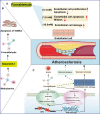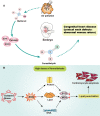The cellular function and molecular mechanism of formaldehyde in cardiovascular disease and heart development
- PMID: 33973354
- PMCID: PMC8184665
- DOI: 10.1111/jcmm.16602
The cellular function and molecular mechanism of formaldehyde in cardiovascular disease and heart development
Abstract
As a common air pollutant, formaldehyde is widely present in nature, industrial production and consumer products. Endogenous formaldehyde is mainly produced through the oxidative deamination of methylamine catalysed by semicarbazide-sensitive amine oxidase (SSAO) and is ubiquitous in human body fluids, tissues and cells. Vascular endothelial cells and smooth muscle cells are rich in this formaldehyde-producing enzyme and are easily damaged owing to consequent cytotoxicity. Consistent with this, increasing evidence suggests that the cardiovascular system and stages of heart development are also susceptible to the harmful effects of formaldehyde. Exposure to formaldehyde from different sources can induce heart disease such as arrhythmia, myocardial infarction (MI), heart failure (HF) and atherosclerosis (AS). In particular, long-term exposure to high concentrations of formaldehyde in pregnant women is more likely to affect embryonic development and cause heart malformations than long-term exposure to low concentrations of formaldehyde. Specifically, the ability of mouse embryos to effect formaldehyde clearance is far lower than that of the rat embryos, more readily allowing its accumulation. Formaldehyde may also exert toxic effects on heart development by inducing oxidative stress and cardiomyocyte apoptosis. This review focuses on the current progress in understanding the influence and underlying mechanisms of formaldehyde on cardiovascular disease and heart development.
Keywords: atherosclerosis; cardiovascular disease; formaldehyde; heart development; semicarbazide-sensitive amine oxidase.
© 2021 The Authors. Journal of Cellular and Molecular Medicine published by John Wiley & Sons Ltd and Foundation for Cellular and Molecular Medicine.
Conflict of interest statement
The authors have declared that no competing interest exists.
Figures



References
-
- Puchtler H, Meloan SN. On the chemistry of formaldehyde fixation and its effects on immunohistochemical reactions. Histochemistry. 1985;82(3):201‐204. - PubMed
-
- Song X, Han X, Yu F, Zhang J, Chen L, Lv C. A reversible fluorescent probe based on C[double bond, length as m‐dash]N isomerization for the selective detection of formaldehyde in living cells and in vivo. Analyst. 2018;143(2):429‐439. - PubMed
-
- Casanova M, Heck H, Everitt J, Harrington W, Popp JJF. Formaldehyde concentrations in the blood of rhesus monkeys after inhalation exposure. Food Chem Toxicol. 1988;26(8):715‐716. - PubMed
-
- Dorokhov Y, Shindyapina A, Sheshukova E, Komarova TV. Metabolic methanol: molecular pathways and physiological roles. Physiol Rev 2015;95(2):603‐644. - PubMed
Publication types
MeSH terms
Substances
Grants and funding
LinkOut - more resources
Full Text Sources
Other Literature Sources
Research Materials
Miscellaneous

